Physical Address
304 North Cardinal St.
Dorchester Center, MA 02124
This chapter summarizes key evidence on the determinants of stroke, focusing on risk factors that are relatively common and modifiable, and interventions intended to reduce the risk of a first stroke.
Data from large, prospective epidemiologic cohort studies and selected clinical trial data are summarized.
Carotid bruits increase the risk of stroke two- to threefold, but should be considered as markers of systemic atherosclerotic burden rather than as an indicator of local stenosis in asymptomatic patients.
Major risk factors for stroke include elevated blood pressure, diabetes, smoking, prior cardiovascular events or current cardiovascular diseases (coronary heart disease, heart failure, atrial fibrillation, peripheral vascular disease), obesity, low high-density lipoproteins (HDL) cholesterol, low levels of physical activity, a positive family history of stroke before age 65, and several circulating biomarkers such as homocysteine levels and indices of inflammation.
The metabolic syndrome, use of oral contraceptives and estrogen replacement after menopause, migraine, heavy alcohol use, obstructive sleep apnea syndrome, stress, HIV, cocaine use, air pollution, and social networks are other potential stroke risk factors and are also discussed.
Risk factors tend to cluster and need to be considered together in estimating stroke risk in individuals; the Framingham Stroke Risk Profile can help predict the risk of stroke and the General Cardiovascular Risk Score and Atherosclerosis Pooled Risk Calculator can each predict the combined 10-year risk of cardiovascular and stroke events.
Treatments for elevated blood pressure and hypertension, diabetes, hypercholesterolemia, and atrial fibrillation are among those that can reduce the risk of a first stroke.
Prevention is the most effective strategy for reducing the health and economic consequences of cerebrovascular diseases. Ten potentially modifiable risk factors are collectively associated with about 90% of the population attributable risk of stroke in each major region of the world, among different race-ethnic groups, in both sexes, and at all ages. Epidemiologic and other observational studies identify the burden of disease and factors associated with stroke, and these are discussed in the initial half of this chapter. Identification of risk factors may also be based on examining the effect on stroke risk reduction, of public health strategies that change mean levels of a putative risk factor. Controlled trials are the gold standard to assess the effects of specific risk factor modifications and are discussed in the second half of this chapter.
Worldwide, stroke was the second most common cause of death in 2016, with 5.5 million (95% uncertainty interval [UI] 5.3–5.7) deaths and 116.4 million (111.4–121.4) disability-adjusted life years (DALYs) lost. , Cerebrovascular disease is currently the fifth most common cause of death in the United States, behind heart disease, cancer, chronic lower respiratory diseases, and unintentional accidents. Among neurologic diseases globally, stroke accounted for the largest proportion of total deaths (67.3%) and DALYs (47.3%). Stroke is a growing problem as life-expectancy increases, and there are larger numbers of older persons at risk for stroke. Worldwide, the mean lifetime risk of stroke increased from 22.8% in 1990 to 24.9% in 2016 (relative increase of 8.9% [95% UI 6.2–11.5]). Further discussion of the global impact of stroke is covered in Chapter 14 .
In 2015, stroke accounted for about 1 out of every 19 deaths in the United States. About 62% of these deaths occurred outside of an acute care hospital. The adjusted mortality rate in the country for stroke was 37.6/100,000 population. Mortality rates were higher in black men (57.0/100,000) and black women (47.9/100,000) compared to other race-ethnic groups. Nearly 60% of stroke deaths in 2015 occurred in women. Based on epidemiologic studies, 28- to 30-day stroke-related case-fatality rates vary across regions and countries from 10% in Dijon, France (2000–2004), to 37%–42% in India. Between 1990 and 2015, deaths due to stroke increased by 36.4% (95% UI 32.4–40.8.).
Although stroke-related mortality in the United States had declined over the last 4 decades, 2015 data shows that the annual reduction decreased and in some subpopulations has actually increased, raising a new public health concern.
In 2014–2015, the estimated direct and indirect cost of stroke in the United States was $45.5 billion, with a mean direct cost of $28.0 billion. The mean per-patient expense for direct care was estimated at $7902. The total direct costs of stroke are projected to more than double from $36.7 billion in 2015 to $94.3 in 2035.
The United States lacks a nation-wide epidemiologic system to track stroke incidence. Although largely limited to whites, the Framingham Study provides prospective stroke incidence data for 9152 men and women ages 30–62 who were free of stroke at study entry in 1950. The population was evaluated every 2 years between 1950 and 2004 for stroke risk factors, with new strokes assessed during three periods (1950–1977, 1978–1989, 1990–2004). There were 1030 incident clinical strokes recorded in 9152 persons (aged ≥55 years) with more than 174,917 person years of follow-up (61% ischemic strokes). Age-adjusted annual incidence decreased from 7.6 to 5.3 per 1000 person years in men and from 6.2 to 5.1 in women. The average annual incidence of stroke approximately doubled in successive decades after age 55 years. Overall, the annual age-adjusted (ages 35–94 years) total initial completed stroke event rates were 5.89/1000 in men and 4.91/1000 in women; a 20% excess was found in men ( Table 16.1 ). The annual age-adjusted (ages 35–94 years) incidence of transient ischemic attack (TIA) was 1.2/1000 in men and 0.7/1000 in women and also increased with age. Table 16.1 also provides incidence data for atherosclerotic brain infarction (ABI), which includes large artery and lacunar strokes. A prospective study of 14,357 participants (282 097 person years) in the Atherosclerosis Risk in Communities (ARIC) study who were free of stroke at baseline and followed between 1987 and 2011 found a crude incidence rate of 3.73 (95% confidence interval [CI] 3.51–3.96) per 1000 person years for ischemic stroke and 0.49 (95% CI 0.41–0.57) per 1000 person years for hemorrhagic stroke.
| Age | Men | Women | Men/Women Combined | |||
|---|---|---|---|---|---|---|
| n | Rate/1000 | n | Rate/1000 | n | Rate/1000 | |
| ABI | ||||||
| 35–44 | 1 | 0.12 | 1 | 0.1 | 2 | 0.11 |
| 45–54 | 15 | 0.97 | 13 | 0.67 | 28 | 0.81 |
| 55–64 | 37 | 1.94 | 35 | 1.4 | 72 | 1.64 |
| 65–74 | 80 | 5.14 | 68 | 3 | 148 | 3.87 |
| 75–84 | 79 | 9.06 | 119 | 7.52 | 198 | 8.07 |
| 85–94 | 16 | 8.64 | 72 | 13.79 | 88 | 12.44 |
| Total | 228 | 3.60 a | 308 | 2.90 a | 536 | 3.21 |
| Completed Stroke | ||||||
| 35–44 | 3 | 0.37 | 3 | 0.3 | 6 | 0.33 |
| 45–54 | 25 | 1.61 | 20 | 1.04 | 45 | 1.29 |
| 55–64 | 60 | 3.15 | 60 | 2.41 | 120 | 2.73 |
| 65–74 | 127 | 8.16 | 115 | 5.08 | 242 | 6.33 |
| 75–84 | 126 | 14.45 | 203 | 12.83 | 329 | 13.41 |
| 85–94 | 30 | 16.21 | 121 | 23.18 | 151 | 21.35 |
| Total | 371 | 5.89 a | 522 | 4.91 a | 893 | 5.35 |
Recent data suggest that stroke incidence may be stable or increasing in young adults. Between 2000 and 2010, hospitalizations for acute ischemic stroke (AIS) per 100,000 population decreased for those age 65–84 years (from 846 to 605) and those age ≥85 years (from 2077 to 1618), but increased for those age 25–44 years (from 16 to 23) and those age 45–64 years (from 149 to 156). A recent examination of temporal trends in the incidence of stroke among Framingham Study participants aged 35–55 years, over the 50-year period since 1962, showed that there was no significant decrease over this time period. While the overall age-adjusted incidence of intracerebral hemorrhage (ICH) in the Framingham Study has decreased slightly from 1948 to 2016, increasing incidence rates were found among patients 75 and older. Four risk factors (hypertension, low physical activity, smoking, and alcohol consumption) explain nearly 80% of the risk. The incidence of stroke associated with pregnancy, especially during the postpartum period, is also increasing. This risk is most strongly associated with hypertensive disorders of pregnancy—particularly preeclampsia. The increasing risk of stroke in young adults, associated with the increasing prevalence of traditional stroke risk factors in this age group, reinforces the critical role of preventive interventions. The risk of stroke is higher in Hispanic and black communities than in whites ( Fig. 16.1 ). The impact of race and ethnicity on stroke risk are further described in Chapter 15 .
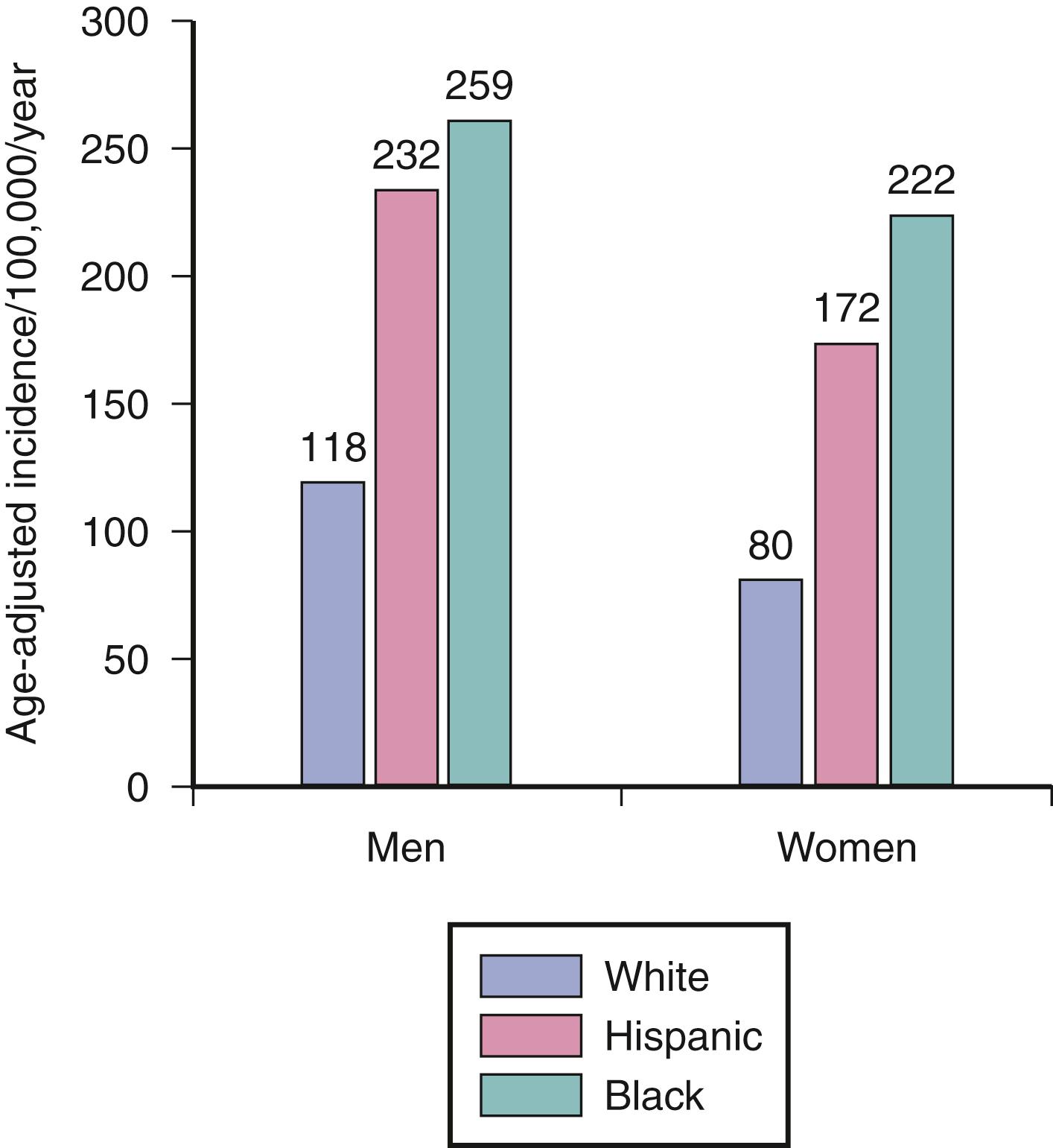
In the Framingham Study, diagnosis of lacunar infarction was based on clinical and brain computed tomography (CT) and magnetic resonance imaging (MRI) scan findings, whereas criteria for embolic infarction required a definite cardiac source for embolism. The identification of cerebral infarction resulting from extracranial versus intracranial arterial disease was made on clinical grounds relying on non-invasive carotid studies and magnetic resonance angiography. Catheter angiography was obtained infrequently by the study subjects’ treating physicians, chiefly in cases of extracranial carotid stenosis before endarterectomy or with subarachnoid hemorrhage (SAH). The occurrence of TIA was obtained by systematic routine questioning on each biennial examination after 1971 and by review of physician records and hospital notes. In addition to the 15.1% of ABIs that were preceded by TIA, there were 148 persons whose initial cerebrovascular symptoms fulfilled criteria for TIA but who did not have a subsequent stroke. These isolated TIAs accounted for 14.8% of total cerebrovascular events in men and 12.7% of events in women.
The relative frequency of completed stroke by type was nearly identical in men and women ( Table 16.2 ). ABI, which included infarction secondary to large vessel atherothrombosis, lacunar infarction, and infarction of undetermined cause, occurred more frequently in men (61.5%) than in women (60.0%). Intracranial hemorrhage accounted for 14.0% of completed strokes in men and 13.4% in women. Although greater numbers of ICHs and SAHs occurred in women, age-adjusted annual incidence rates for ICH were higher in men (0.52 vs. 0.38 per 1000); rates of SAH were not appreciably different (0.29/1000 in men and 0.28 in women). The relative frequency of ICH and SAH varied by the age of the population studied: SAH predominates below age 65 and becomes equivalent to ICH at ages 65–74 years. At ages 75–84 years, ICH predominates, with an incidence of 1.26/1000 annually compared with 0.29/1000 for SAH.
| Completed Stroke | Men | Women | Total | |||
|---|---|---|---|---|---|---|
| n | % | n | % | n | % | |
| Atherothrombotic brain infarction | 228 | 61.5 | 308 | 59 | 536 | 60 |
| Cerebral embolus | 87 | 23.5 | 137 | 26.2 | 224 | 25.1 |
| Subarachnoid hemorrhage | 20 | 5.4 | 28 | 5.4 | 48 | 5.4 |
| Intracerebral hemorrhage | 32 | 8.6 | 42 | 8 | 74 | 8.3 |
| Other | 4 | 1.1 | 7 | 1.3 | 11 | 1.2 |
| Total | 371 | 100 | 522 | 100 | 893 | 100 |
Meta-regression analysis based on 65 studies conducted between 1993 and 2015 showed an increasing temporal trend for cardioembolism in whites (2.4% increase annually, P = .008) and large artery atherosclerosis in Asians (5.7% annually, P < .001), and a decrease in small artery occlusion in whites (−4.7% annually, P = .001). There was, however, considerable heterogeneity between studies.
Radiologic evidence of ischemic brain injury and small vessel-type disease on CT or MRI brain in persons with no known related symptoms is common. In 1989, the Framingham Study reported the first population-based CT confirmation of the high prevalence (10%–11%) of silent cerebral infarction, a finding that that was later also noted in other studies. Infarct-like lesions on brain MRI were found in 36% of participants in the Cardiovascular Health Study. They have been found in otherwise healthy persons with hypertension, diabetes, and elevated levels of plasma homocysteine, and in patients with other evidence of atherosclerotic vascular disease (ASVD). Mendelian randomization studies confirm blood pressure elevation as a risk factor for silent strokes. Although the manifestations of these silent infarcts are clinically inapparent, they are associated with an increased risk of later stroke, cognitive impairment, and depressed mood. A systematic review found that silent brain infarction is present in about 20% of clinically stroke-free older adults and is associated with a twofold increased risk of future stroke.
Of the 795,000 people in the United States having a stroke each year, approximately 610,000 are first attacks and 185,000 occur in those with a history of stroke. Recurrent stroke is common and likely to increase in frequency in the population as life expectancy increases and the stroke case fatality rates decline. The immediate period after a stroke is critical for recurrence.
A meta-analysis of 13 hospital or community-based studies found a cumulative stroke recurrence risk of 3.1% (95% CI 1.7–4.4) at 30 days, 11.1% (95% CI 9.0–13.3) at 1 year, 26.4% (95% CI 20.1–32.8) at 5 years, and 39.2% (95% CI 27.2–51.2) at 10 years. Mortality from recurrent stroke is higher than after a first stroke.
Many of the same risk factors that predispose to initial strokes increase the risk of recurrences. Known modifiable stroke risk factors include hypertension, smoking, obesity, heavy alcohol consumption, impaired glucose tolerance, and physical inactivity. Prognosis after stroke is addressed in Chapter 17 .
A variety of biomarkers, including inflammatory markers, are associated with the risk of recurrent stroke, but the data are inconsistent. A case-cohort study found no association between time to recurrent stroke and levels of lipoprotein-associated phospholipase A2, monocyte chemoattractant protein-1 (MCP-1), resistin, matrix metalloproteinase-9, N-terminal fragment of pro-B-type natriuretic peptide, soluble vascular cell adhesion molecule-1, soluble intercellular adhesion molecule-1, or soluble CD40 ligand. In adjusted analyses, osteopontin (hazard ratio [HR] per standard deviation change 1.362; P < .0001), neopterin (HR 1.137; P = .0107), myeloperoxidase (HR 1.177; P = .0022), and adiponectin (HR 1.207; P = .0013) were independently associated with a second stroke. After adjustment for the Stroke Prognostic Instrument-II and treatment, osteopontin, neopterin, and myeloperoxidase remained independently associated with recurrent strokes.
Ischemic stroke often reflects diffuse vascular atherosclerosis. ABIs are associated with an approximate twofold excess risk of cardiac failure and coronary disease, presumably on the basis of diffuse atherosclerosis. Cardiac failure occurs in about 15% of stroke patients over a period of 10 years and at essentially identical rates in men and women ( Table 16.3 ). Coronary events can be expected in 44% of men and in 25% of women who have had a stroke because of shared risk factors such as hypertension and diabetes. Conversely, various cardiac conditions increase stroke risk.
| Points a | Total Points | 5-Year Risk (%) | |
|---|---|---|---|
| Age (years) | 0–1 | 5 | |
| 50–59 | 0 | 2–3 | 6 |
| 60–62 | 1 | 4 | 7 |
| 63–66 | 2 | 5 | 8 |
| 67–71 | 3 | 6–7 | 9 |
| 72–74 | 4 | 8 | 11 |
| 75–77 | 5 | 9 | 12 |
| 78–81 | 6 | 10 | 13 |
| 82–85 | 7 | 11 | 14 |
| 86–90 | 8 | 12 | 16 |
| 91–93 | 9 | 13 | 18 |
| >93 | 10 | 14 | 19 |
| Diabetes | 15 | 21 | |
| No | 0 | 16 | 24 |
| Yes | 5 | 17 | 26 |
| Prior stroke or TIA | 18 | 28 | |
| No | 0 | 19 | 31 |
| Yes | 6 | 20 | 34 |
| Systolic BP (mm Hg) | 21 | 37 | |
| <120 | 0 | 22 | 41 |
| 120–139 | 1 | 23 | 44 |
| 140–159 | 2 | 24 | 48 |
| 160–179 | 3 | 25 | 51 |
| >179 | 4 | 26 | 55 |
| Sex | 27 | 59 | |
| Male | 0 | 28 | 63 |
| Female | 6 | 29 | 67 |
| 30 | 71 | ||
| 31 | 75 |
a Add points to determine the 5-year risk of stroke as indicated in the total point score.
Epidemiologic data indicate that the development of a clinical atherosclerotic event in one arterial vascular territory is usually a hallmark of diffuse atherosclerosis and an increased risk of clinical atherosclerotic events in other areas. The presence of cardiovascular risk factors common to all atherosclerotic cardiovascular diseases suggests a common pathogenesis promoting atherosclerosis in all vascular territories; however, differences exist. Each of the common risk factors independently contributes to the occurrence of stroke and other ASVDs, but the risk each imposes varies depending on the associated burden of other risk factors. This necessitates global risk evaluation with the use of multivariable risk assessments, as discussed later in this chapter.
It is also important to recognize that stroke-associated morbidity and mortality are strongly affected by the occurrence of other cardiovascular events. For example, the risk of death is increased in persons with a stroke, but this mortality risk occurs not only from stroke but also from cardiac failure and coronary heart disease. For example, carotid bruits are associated with an increased risk of stroke and can also indicate the presence of coronary disease, heart failure, and peripheral artery disease.
Vascular bruits, caused by turbulent blood flow, can signify the presence of diffuse as well as local vascular disease. The femoral and carotid arteries are readily accessible for auscultation and the noninvasive assessment to detect the presence of obstructed blood flow, which if present can be an indicator of risk for stroke and cardiovascular events. Although femoral bruits are associated with a 20%–30% prevalence of intermittent claudication, they are also associated with an increased prevalence of atherothrombotic disease in other vascular territories.
Similarly, an anterior cervical bruit can be an indicator of vascular disease in the cerebral circulation. The presence of a bruit in this location is associated with a two- to threefold increase in the risk of stroke. Anterior cervical bruits, however, are also associated with a two- to threefold increase in the risk of developing peripheral artery disease. Detection of an anterior cervical bruit is the most common physical examination finding leading to the diagnosis of an asymptomatic carotid artery stenosis. A TIA is the most common expression of symptomatic carotid stenosis. Population-based data indicate that anterior cervical bruits are present in 4%–5% of persons age greater than 45 years and that its prevalence increases from 1% to 3% for those age 45–54 years to 6%–8% for persons older than 75 years.
The Framingham Study population data indicate that anterior cervical bruits are associated with a stroke rate twice that expected for age and sex. The brain infarction, however, most often occurs in a different vascular territory with lacunar infarction being the mechanism of stroke in nearly half the cases. An anterior cervical bruit is clearly an indicator of increased risk of stroke, but most commonly as a consequence of systemic vascular disease and not necessarily as a direct effect of the local stenosis.
Because the pathophysiologies underlying the various stroke types differ, risk factors for infarction can differ from those for brain hemorrhage, although they have several risk factors in common. Furthermore, precursors of ICH differ from those for SAH. Risk factors for stroke from atherosclerosis of the carotid and vertebral arteries may differ in their impact compared with risk factors for lacunar infarction and embolic stroke. Nevertheless, certain predisposing factors, such as elevated blood pressure and combustible tobacco smoke exposure, are common to most stroke types.
Risk factors for ischemic strokes, whether they are large artery atherosclerotic, lacunar or cardioembolic infarcts, include elevated blood pressure, abnormal blood lipid levels, diabetes, high fibrinogen and other clotting factors, obesity, cardiac diseases (i.e., CHD, congestive heart failure [CHF], atrial fibrillation [AF], left ventricular hypertrophy, and echocardiographic abnormalities), race-ethnicity, family history, and several circulating biomarkers, such as homocysteine levels and indices of inflammation. Lifestyle factors such as smoking, physical inactivity, diet, alcohol and illicit drug use, environmental conditions such as air pollution, and medication use, such as oral contraceptives (OCs) or hormonal replacement therapy, are also risk factors for ischemic stroke.
Hypertension is the single most important modifiable risk factor for both ischemic stroke and ICH. Hypertension also predisposes to cardiac stroke precursors (notably myocardial infarction [MI] and AF) that increase the risk of cerebral embolism. In addition, elevated blood pressure raises the risk of aneurysmal SAH.
About 77% of people who have a first stroke, about 69% who have a first heart attack, and about 74% who have heart failure have blood pressures higher than 140/90 mm Hg (National Heart, Lung, and Blood Institute unpublished estimates). People with systolic blood pressures (SBPs) ≥160 mm Hg and/or diastolic blood pressures (DBPs) ≥95 mm Hg have a relative risk (RR) of stroke about four times greater than for those with normal blood pressures. Hypertension contributes to the risk of stroke in both sexes at all ages, including in those age 75–84 years. The effect on risk remains after adjustment for age and other pertinent risk factors ( Fig. 16.2 ).
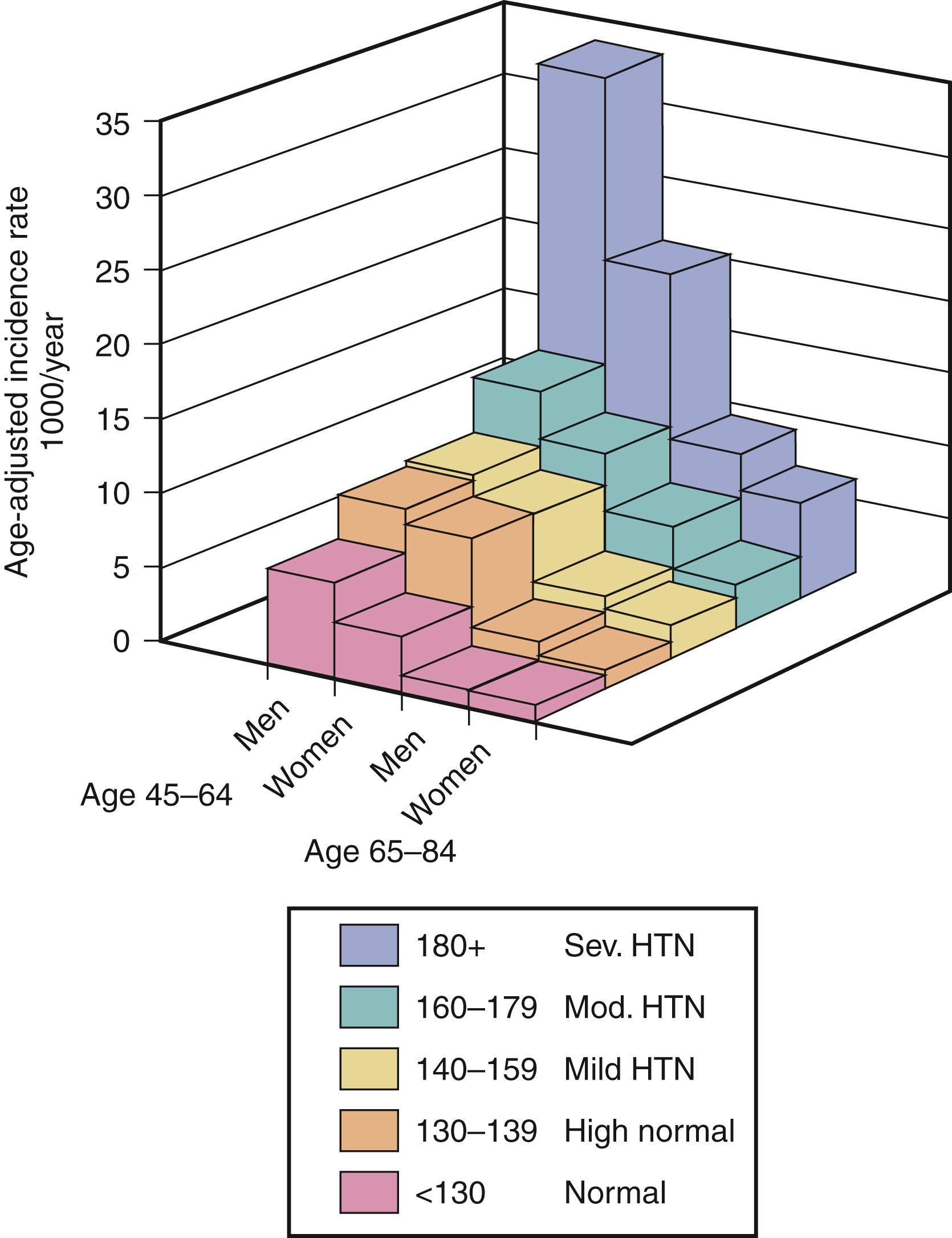
The risk of stroke increases with increasing blood pressure, even in the prehypertension blood pressure (120–139/80–89 mm Hg) range. When Framingham cohort subjects are classified by the Joint National Committee VII SBP categories, it is clear that the incidence of stroke increases with increasing blood pressure levels (see Fig. 16.2 ). More initial stroke events (both infarction and hemorrhage), however, occur in persons with stage I (mild) hypertension (SBP, 140–159 mm Hg) than in any other group (see Fig. 16.2 ). Approximately half of the initial stroke events in the Framingham cohort occurred in subjects with pressures in the prehypertension/high normal (systolic pressure, 130–139 mm Hg) or in the mild hypertension categories ( Fig. 16.3 ); this observation justifies current guidelines that recommend a target BP of 130/80 mm Hg for primary or secondary prevention of cardiovascular disease, including stroke. Based on data from one million adults with no previous vascular disease at baseline assessed in 61 prospective observational studies, at ages 40–69 years, every difference of 20 mm Hg above 115 mm Hg in usual SBP or 10 mm Hg DBP is associated with an approximate doubling in the stroke, ischemic heart disease, and other vascular mortality rates. Proportional differences were half as large in those ages 80–89 years, and similar for men and women and for ischemic and hemorrhagic stroke. Risk increases with both SBP and DBP at all ages.
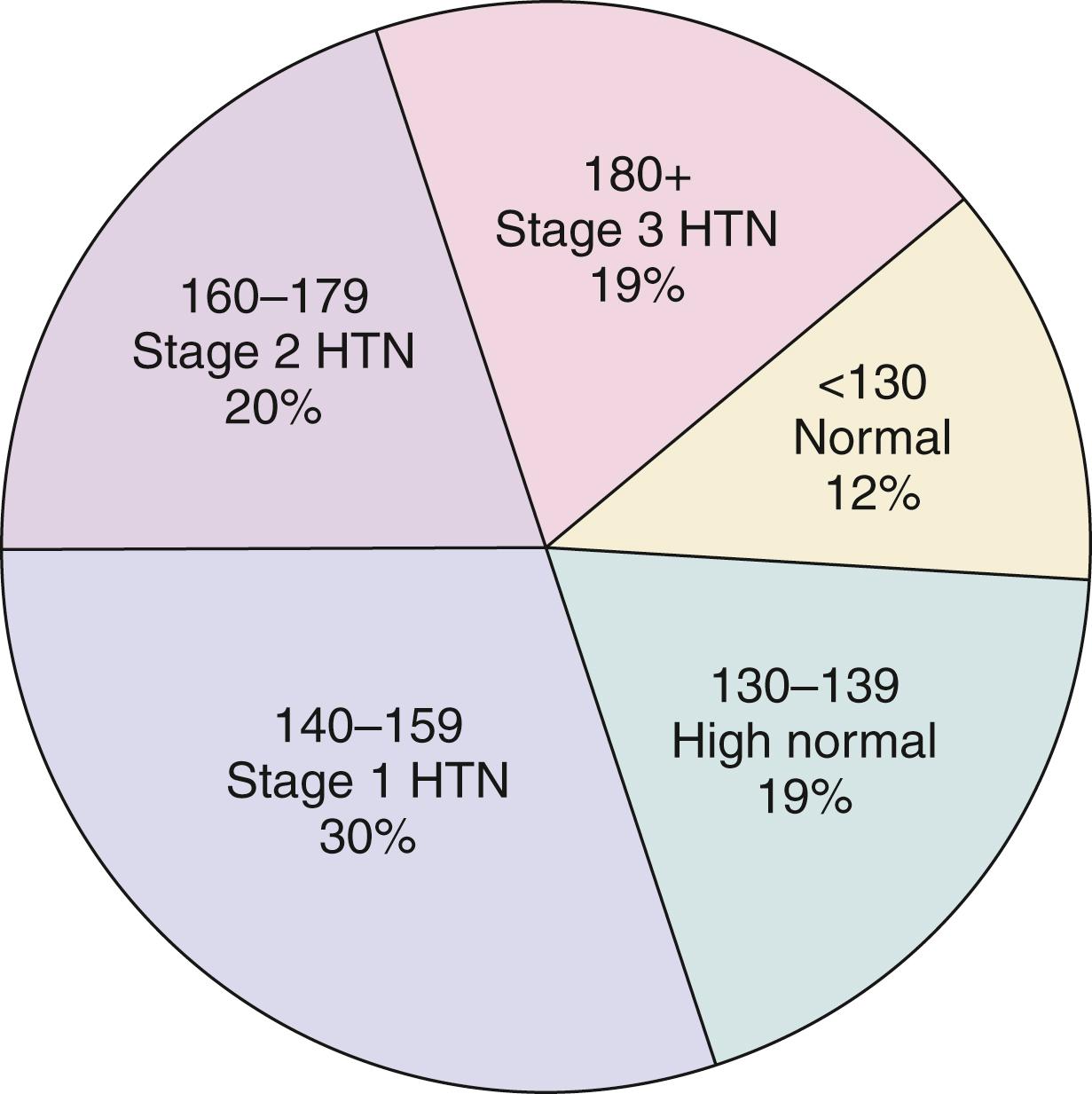
Isolated systolic hypertension (≥160/<90 mm Hg) becomes increasingly prevalent in the elderly, affecting approximately 25% of persons age ≥80 years. In the Framingham Study, men age 65–84 years with isolated systolic hypertension had double the risk of stroke, with the risk increased by 1.5-fold for women. Antihypertensive therapy in those age ≥80 years was associated with a 30% reduction in fatal and nonfatal strokes.
Blood pressure-related stroke risk predictions are generally based on the measurement of current blood pressure. Risk, however, depends on the degree of blood pressure elevation over time. Data from 50 years of blood pressure assessments from the Framingham Study show that elevated midlife blood pressure during the prior 10 years increases the RR of stroke by 1.7-fold per standard deviation increment in women and by 1.9-fold per standard deviation increment in men at age 60 years and 70 years.
Although a clear linear relationship exists between serum cholesterol levels and coronary heart disease, the relationship between serum cholesterol and stroke is more complex. The association between increasing usual total cholesterol levels and stroke risk is weak and inconsistent. A meta-analysis of 45 prospective cohorts involving 450,000 people and 13,000 incident strokes found no relationship between total cholesterol and stroke. Other studies found a small association between higher total or low-density lipoprotein (LDL) cholesterol levels and increasing ischemic stroke risk; however, lower total or LDL cholesterol is associated with an increased risk of hemorrhagic stroke. These competing risks may, in part, explain the lack of a relationship between cholesterol levels and overall stroke rates.
An individual-data meta-analysis of nearly 900,000 patients from 61 studies found only a weak positive association between total cholesterol and total stroke mortality at ages 40–59 years, with no association at older ages. A weak positive association was also found between total cholesterol and ischemic stroke with a negative association with hemorrhagic stroke. For both total and ischemic stroke mortality, associations were larger, with a baseline systolic BP less than 145 mm Hg.
Most studies, including the Framingham Study, find an inverse relationship between HDL cholesterol and stroke risk. The risk of large artery atherosclerotic infarcts may be most strongly related to low HDL-cholesterol levels and to the ratio of total cholesterol to HDL.
The relationship between triglycerides and ischemic stroke is inconsistent. Triglyceride levels were not associated ischemic stroke in the ARIC Study, but a meta-analysis of prospective studies in the Asia-Pacific region showed a 50% increase in ischemic stroke risk for those with the highest versus the lowest levels.
Data from randomized trials show statin therapy reduces the risk of stroke among patients with established coronary heart disease and in those at increased vascular risk. There is an approximate 21% decrease in stroke for each mmol/L decrease in LDL cholesterol. Statin therapy did not lead to an increased risk of hemorrhagic stroke in primary stroke prevention populations. Other lipid-modification therapies, including niacin, fibric acid derivatives, bile acid sequestrants, and ezetimibe, also have favorable effects on lipid profiles.
The Honolulu Heart Program found that increasing degrees of glucose intolerance conferred an increasing risk of thromboembolic stroke that was independent of other risk factors, but there was no relationship between glucose level and hemorrhagic stroke ( Fig. 16.4 ). The RR for stroke associated with diabetes was 1.8 in men and 2.2 in women in another population-based cohort study, even after adjustment for other pertinent risk factors. In the Framingham Study, both men and women at all ages with glucose intolerance had approximately double the risk of ABI compared with those without diabetes.
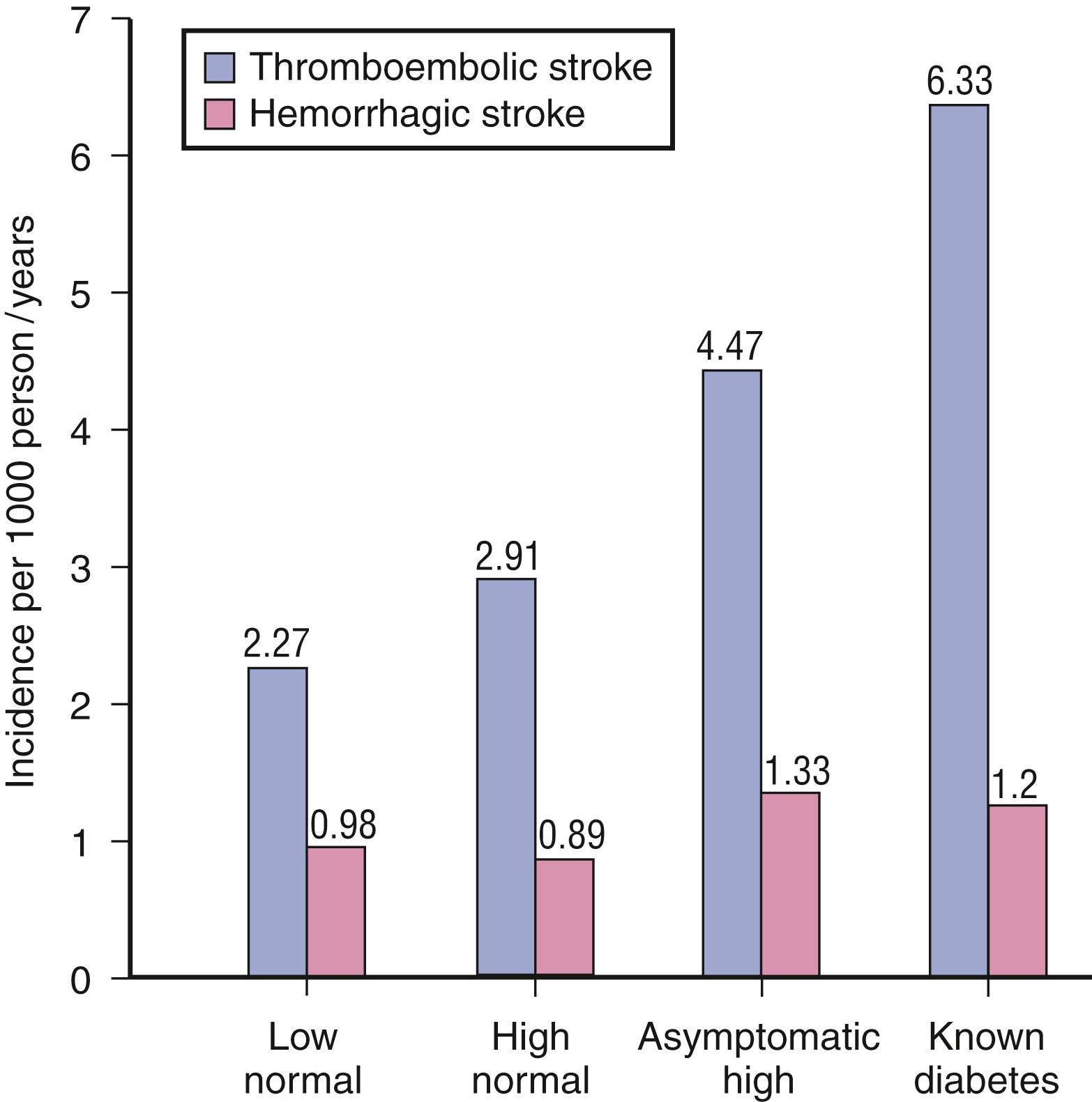
Data from the Framingham Study also found that those with a metabolic syndrome, an indicator of insulin resistance, had a substantial risk of stroke. The risk in persons with both diabetes and metabolic syndrome (RR 3.28, 95% CI 1.82–5.92) was higher than that for either condition alone (metabolic syndrome alone RR 2.10, 95% CI 1.37–3.22, diabetes alone RR 2.47, 95% CI 1.31–4.65). The population-attributable risk was greater for metabolic syndrome alone than for diabetes alone (19% vs. 7%), particularly in women (27% vs. 5%). Prevention and control of the metabolic syndrome and its components, particularly hypertension, are likely to reduce stroke incidence ( Fig. 16.5 ).
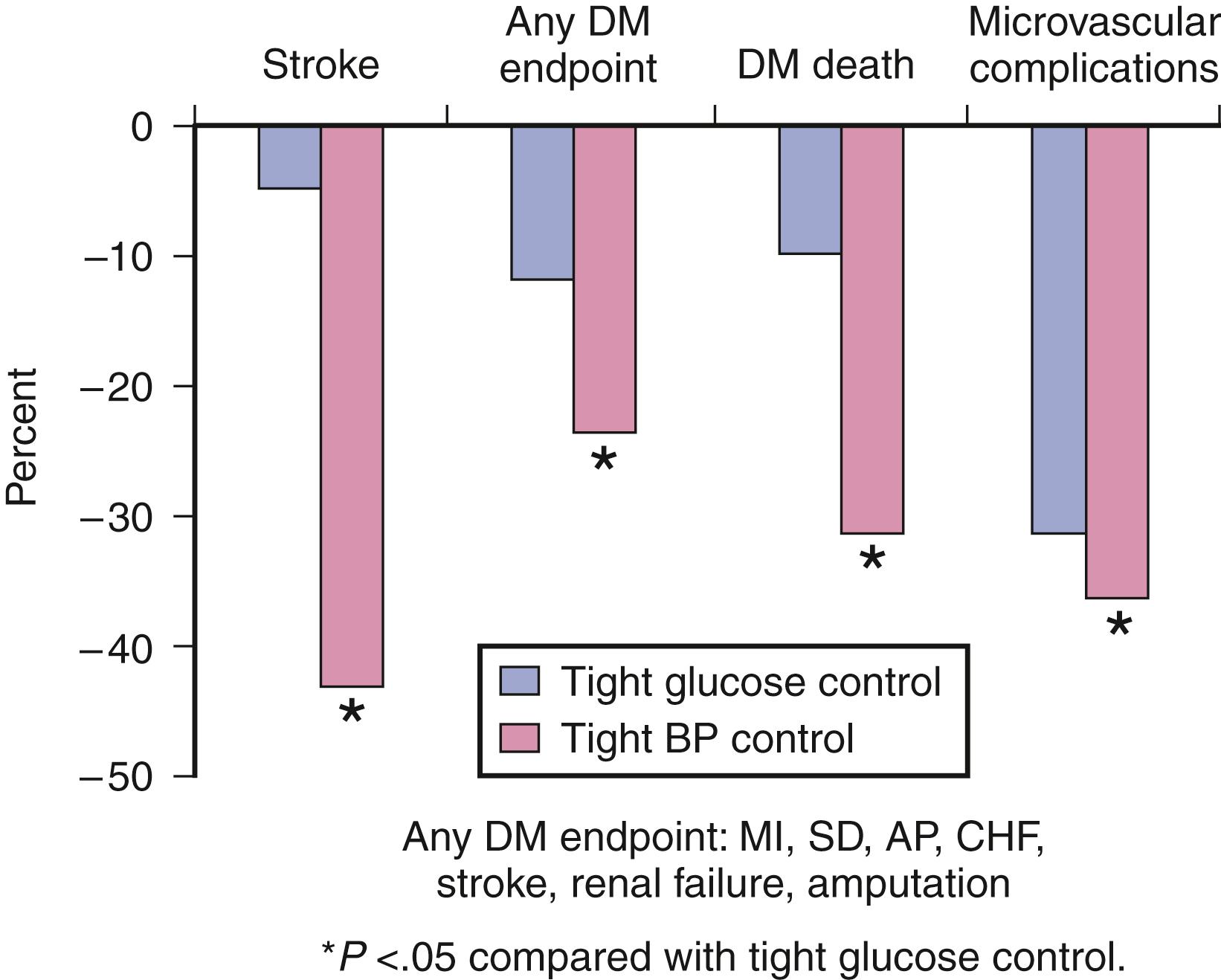
Become a Clinical Tree membership for Full access and enjoy Unlimited articles
If you are a member. Log in here